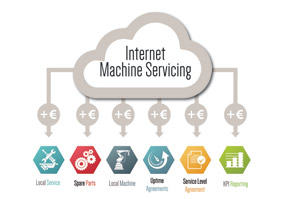By adopting the latest Internet 4.0 technologies, machine builders and process equipment suppliers can maximise their revenues by offering new value-added services that improve their customers’ performance, says John Pritchard, Managing Director at MAC Solutions.
As technology becomes easier and faster to copy by low cost competitors, manufacturers are now seeking out new services to offer to their customers, in order to give their machines or process equipment an edge over competing products. Leading equipment suppliers around the world now increasingly provide a variety of services – from 24/7 spare parts delivery to predictive maintenance, remote condition monitoring and availability guarantees – to not only improve their own machines, but also to improve their customer’s performance.
The latest research shows that the most successful OEMs and machine builders are now generating between 20-40% of their revenues and profits from services rather than ‘pure’ manufacturing. However, few of these companies, particularly small-to-medium sized OEMs and process equipment manufacturers, actually know the route to enabling this type of business model.

The key enabler to this ‘machine servicing’ approach is the explosion in manufacturing devices connected over Internet communications technology. Manufacturers have moved from being ‘unconnected’ to being able to talk and listen to their machines and technologies. The more forward-thinking OEMs are, for example, already collecting data remotely across the Internet on a routine basis, and then using this data to offer improved services to their customers, or to create new offerings that can be delivered anywhere in the world. These value-added services are enabling a raft of benefits, including improved machine performance; reduced production costs; the prediction of future maintenance needs; improved training methods; improved management of service level agreements; increased customer loyalty; and the creation of new, sustainable revenue streams. Key to this machine-servicing or “Internet-Servicing” approach is to understand and then utilise the latest, cutting edge “Industry 4.0” technology.
What is Industry 4.0?
Industry 1.0 began with the industrial revolution, which was followed in the early 1900s by Industry 2.0 – the rise of mass production. The third phase, Industry 3.0, started in the late 1960s with the introduction of computer-based manufacturing. This phase saw the introduction of programmable logic controllers (PLCs), the beginning of modern control and automation as we know it today.
According to industry experts, the future of manufacturing and the next step in our digital evolution is “Industry 4.0”. Introduced by the German Government as a way of promoting the computerisation of manufacturing, Industry 4.0 describes the next major step towards truly global manufacturing. Here, processes are no longer viewed as separate entities, but as one integrated “cyber-physical” system comprising of processors, sensors, software and communication technologies.
Although we may still be some years away from Industry 4.0, there are now strong signals emerging that the world is preparing for it. By connecting production systems, machines, processes and workpieces, intelligent networks can be created along the entire value chain that can control each other autonomously. Take, for example, a machine that is able to predict failures and trigger maintenance activity autonomously, without any manual intervention.
Internet-Servicing for machine builders
So how can OEMs and machine builders leverage Internet 4.0 and Internet-Servicing technologies in order to improve their own service offerings and their customers’ performance?
Cost and resources are no longer a barrier. To date, the development of remote communications and data collection technologies have been mostly led by larger companies. However, Industry 4.0 and Internet-Servicing technologies are now bringing the power of connectivity to SMEs at an affordable investment that typically pays back within a year.
By equipping their machines or process equipment with the appropriate hardware devices (industrial VPN routers) and by utilising open-standard software and secure Internet communication technologies – which enable machine and process data to be collected, analysed, reported and acted upon – machine builders can ensure that their business is positioned for sustainable growth in an increasingly competitive, connected world – and all of this can be achieved in a safe, secure network.
The components and functionalities of the hardware, software and Internet-Servicing technologies should include the following:
- Analytics
The data historian should provide full reporting capabilities from archived process data over any time period. These reports need to be viewed, distributed and published in-house for the machine builder’s own internal use, as well as viewable across the Internet, by email or Web-server, for the customer’s use.
- Web-Publishing
The software suite should also provide web-publishing functionality, whereby reports, real time data and trended machine/process data can be viewed across the Internet. HMI & SCADA visualisation software based on open standard web-technology (e.g. HTML5, SVG vector graphics) will enable access from any PC, Mac, Mobile or Smart Phone device, without the need for plug-ins or licenses for client devices.
- Alarm Alert & Notification
A mechanism or portal for alarm information is also required. This should provide suitable alarm workflows and an escalation system for delivery of alarms or to notify the appropriate person in the organisation. This software should also ensure that the right action is taken at the right time.
Fortunately, affordable solutions are now available that offer all of the above features and functionalities. Some of these solutions are even provided by single vendors in a single complete package that utilises remote communications technology, industrial VPN routers, data logging, data archiving, trending and analytics – in a software platform that is customisable and based on truly open-standard technologies.










